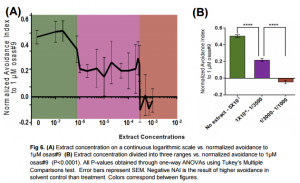Major Qualifying Projects
* Dr. Jagan Srinivasan was a co-advisor
See all lab projects published here!
2025: Gut Feelings: Unraveling the Microbiome’s Influence on Parkinson’s Disease, Korinna Muller ’25
-
Parkinson’s disease (PD), the second most prevalent neurodegenerative disease, has recently seen the sharpest rise in global prevalence among neurological conditions. PD is speculated to originate in the gut, where microbial dysbiosis and inflammation may contribute to the progressive degeneration of midbrain dopaminergic neurons that characterizes PD. This project investigates the potential therapeutic impact of gut microbiome supplementation in a C. elegans PD model. As motor deficits are a hallmark of PD, locomotion in wild-type N2 and PD-model NL5901 strains was assessed using thrashing and crawling speed assays. On a standard E. coli OP50 diet, PD-model animals exhibited impaired motor function compared to wild-type. Substituting OP50 with the CeMbio bacterial mix did not significantly improve motor performance. Thus, gut microbiome supplementation had no conclusive therapeutic impact on the PD model.
-
Huntington’s Disease (HD) is an autosomal dominant neurodegenerative condition caused by an expanded polyglutamine tract in the huntingtin protein, leading to transcriptional dysregulation and motor impairment. Emerging research has connected the gut microbiota to brain health through several mechanisms, including the activity of bacterial metabolite short-chain fatty acids such as butyrate, a known histone deacetylase (HDAC) inhibitor. This study tested whether dietary supplementation with sodium butyrate, the salt form of butyrate, could mitigate HD symptoms in Caenorhabditis elegans models of the disease. Body bend assays revealed that treated HD animals showed a significant improvement in motor response, with performance comparable to wild type (p < 0.0001). However, crawling speed remained significantly impaired in HD models, with no rescue observed post-treatment. These results suggest that sodium butyrate can partially restore sensorimotor function but does not fully reverse HD-related locomotor deficits, highlighting the potential therapeutic avenue for gut-derived epigenetic therapies in neurodegenerative disease.
-
Alzheimer’s disease is a progressive incurable neurodegenerative disorder characterized by the accumulation of beta-amyloid plaques and tau tangles leading to neuron loss and cognitive decline. Alzheimer’s severity is associated with memory loss which can be measured through associative learning assessments. Caenorhabditis elegans (C. elegans) are a reliable model organism for studying neurodegeneration. Recent studies have highlighted the gut-brain axis and the connection between neurological health and the gut microbiome, leading to the development of CeMbio, a mix of bacteria meant to simulate the natural microbiome of C. elegans. CeMbio has been shown to restore some of the motility lost in C. elegans expressing beta-amyloid plaques. This study tests if CeMbio is able to restore associative learning in C. elegans with Alzheimer’s disease through restoration of their gut microbiome.
-
Parkinson’s Disease (PD) is a progressive neurodegenerative disorder of the central nervous system that affects motor abilities. Cannabinoids (CBD) are potential therapeutics for treating PD. C. elegans were used as a model system to analyze two key determinants: reactive oxygen species (ROS) and 6-OHDA induced behavior. This experiment investigated whether the LD1171 GFP-tagged strain is an effective model for studying the effects of CBD treatment. Locomotive trials showed 6-OHDA significantly reduced movement in N2 worms. LD1171 worms exposed to 6-OHDA exhibited increased ROS levels, as indicated by elevated RFUs. CBD treatment following 6-OHDA exposure resulted in reduced RFUs, supporting the potential neuroprotective effects of CBD.
2025: Effect of cannabinoids (CBD) on worm behavior and physiology, Chase Ouellette ’25*
-
Alzheimer’s disease (AD) is associated with increased oxidative stress, known to be triggered by β-amyloid (Aβ) plaque accumulation. Increased reactive oxygen species (ROS) contribute to neuronal damage and reduced function. Cannabidiol (CBD), a non-psychoactive compound, has been shown to modulate oxidative stress by scavenging ROS and influencing antioxidant pathways. In Caenorhabditis elegans models of AD, CBD affects both redox balance and behavior. Preliminary observations by previous MQPs showed that stress induced worms with CBD treatment exhibited decreased motility compared with those without CBD. This suggests a complex interaction between CBD exposure and oxidative stress. To investigate this further, ROS levels will be quantified using a dihydroethidium (DHE) fluorescence assay. Expression of sod-1 and sod-2, genes encoding antioxidant enzymes, will be measured via RT-qPCR to assess molecular changes. Together, this data aims to clarify how CBD influences oxidative pathways and neuronal function in an AD context, offering insights into its potential therapeutic or adverse effects.
-
Alzheimer’s Disease (AD), a neurodegenerative disease that triggers loss of cognitive and behavioral functions, is believed to be caused by β-amyloid plaque deposition in the CNS. This project aimed to determine cannabidiol’s (CBD) impact on locomotive ability, reactive oxygen species (ROS) levels, and superoxide dismutase (SOD) expression in C. elegans strain CL2355, a model for AD. Behavioral assays measured thrashes, while a dihydroethidium (DHE) assay was used to measure ROS levels. RT-qPCR primers were designed to measure SOD1 and SOD2 levels in untreated and CBD treated worms. The results suggest CBD increased mobility and decreased ROS levels, providing preliminary evidence of CBD’s potential to treat AD. Future studies should use RT-qPCR to study CBD’s effect on SOD expression.
2024: Assessing nucleic acid aptamers for the amelioration of copper toxicity, Stephanie Reis ’24 BBT*
- Copper (Cu) is an essential heavy metal required in regulated quantities to support cellular function. However, even though copper is required for these functions, too much copper present in an organism can be toxic and result in negative health impacts. Furthermore, copper metabolism diseases like Wilson’s disease and Menkes disease can result in negative phenotypes when the amount of Cu present is unregulated. Aptamers are short single-stranded DNA or RNA sequences that bind directly to substrates, including toxic metal ions. Aptamers have been widely used for biosensing applications but have not been investigated as prophylactics or therapeutics for heavy metal toxicity. In this study, we document the negative impacts of Cu in the model nematode Caenorhabditis elegans (C. elegans) in the form of reproductive toxicity, neurotoxicity, and survival. We show that brood size of C. elegans is reduced by 50% when exposed to 10mM of Cu, but co-exposure of the Cu binding aptamer and copper did not produce a restorative effect. We have also shown that when exposed to Cu, C. elegans showcase reduced avoidance behavior towards known repellants of glycerol and quinine. Furthermore, our results revealed that co-exposure to copper and the Cu_A2 aptamer was able to restore avoidance behavior towards the quinine repellant to wildtype levels, and restoration was not seen with co-exposure to the scramble or water treatments. Copper has also been shown to have an impact on survival where exposure led to reduced lifespans in both wildtype N2 C. elegans and VC672 strain C. elegans, which have a copper metabolism mutation. We show that co-exposure to the Cu_A2 aptamer and copper in the VC672 strain was able to extend the lifespan of the C. elegans, where longevity was not protected in the C. elegans co-exposed to the scramble or water conditions. Our results suggest that nucleic acid aptamers have potential to be used as prophylactics or therapeutics against toxic heavy metal exposures, and therefore warrant additional investigation.
- E-cigarette use is widely prevalent among young adults. However, there is not much known about the social consequences of nicotine in this age-group. This two-part interdisciplinary project (a) delivered a psychosocial survey focused on vaping behaviors and mental health that was administered to 173 WPI undergraduates and (b). measured social behavioral responses to nicotine exposure in a model organism, C. elegans. Key findings across both studies include the following: 35% of respondents reported they vaped with some degree of regularity. Vaping appears to be a social activity among WPI students and less-so related to psychological mood states. However, younger vapers tended to have higher depressive symptoms. C. elegans exhibit avoidance behavior to increasing concentrations of nicotine. This project emphasized that although vaping is a social activity, there are behavioral consequences at the biological level.
- Alzheimer’s Disease (AD), the most common form of dementia, is a progressive neurodegenerative disease affecting about 10% of all people over the age of 65. There are no cures for AD, and treatment options are limited. Current evidence suggests a potential correlation between gut microbiome dysbiosis and AD development and progression. This study utilized a transgenic Caenorhabditis elegans model of AD to test whether gut microbiome supplementation with individual bacterial strains could hold potential therapeutic power for treatment of AD. Behavioral assays were used to determine the potential amelioration of chemosensation deficiencies in the AD model, and it was found that gut microbiome supplementation with all six tested bacterial strains improved chemosensation in the transgenic AD strain of C. elegans. These results provide further evidence for the potential use of microbiome supplementation as a treatment option for AD.
- Parkinson’s Disease (PD) is a neurodegenerative disease that causes a loss of control in motor function as it progresses. Our project analyzed the ability of Cannabidiol (CBD) to restore movement to or protect against neurodegeneration in C. elegans nematodes with chemically induced PD using 6-OHDA (6-hydroxydopamine). Experiments were conducted in liquid media and recorded under a light microscope for further analysis. The number of times that each worm “turned” was scored to determine the relative activity of each worm. Our results suggest that there may be a benefit to using CBD as both a preventative measure and a treatment for physical symptoms of PD, as there is an increase in relative turn activity seen in nematodes treated with CBD both before and after chemical induction of PD.
- This project aimed to study the relationship between cannabidiol (CBD) and levels of reactive oxygen species (ROS) present in N2 strain C. elegans. It was found that six-hour treatments of two different concentrations of CBD produced inconclusive data regarding the impact of CBD on ROS. Due to the exceedingly high variability in the data, no conclusions could be drawn, suggesting the necessity of further experimentation. Interestingly though, the CBD treatment appeared to increase worm longevity as the CBD samples yielded a higher count of live worms relative to the control samples.
- The purpose of this project was to determine if Cannabidiol could be used to reduce the behavioral effects of 6-OHDA induced Parkinson’s Disease in C. elegans. Behavioral assays measuring thrashes, Omega-, and Delta-turns in liquid media were used to analyze restorative abilities CBD had on the movement of the worms. It was found that CBD was able to increase thrashing behavior from 20/minute to 40/minute in PD worms, and was able to decrease time spent in turns by half. Although conclusions were heavily limited by sample size of the data collected, this project provides preliminary evidence in support of CBD restoring normal movement behaviors for PD-model worms.
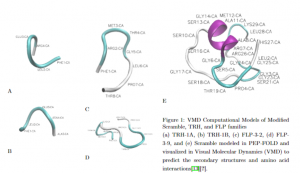
- Neuropeptides are essential to neuron function and significantly affect behavioral response. While neuropeptides are beneficial for behavior, at high concentrations they can be detrimental to cell function. Recent research shows that amino acid substitutions in neuropeptides could lead to changes in the cell entering mechanisms. We investigated the structure-function of modified neuropeptides families of FaRP (FLP-3-2 and FLP-3-9) and TRH (TRH-1A and TRH-1B) using dielectric relaxation spectroscopy (DRS) and circular dichroism (CD). We measured the complex dielectric permittivity and conductivity of the neuropeptides in the frequency range 200mHz to 40MHz at 0.5μM and 1μM. We determined the structure of the neuropeptides using CD data and compared it to computational models. We found that the longer amino acids chain neuropeptide FLP-3-9 has a lower permittivity than FLP-3-2. A decrease in permittivity was also observed when the Arginine and Glycine were substituted with Asparagine and Alanine in TRH. Knowing the complete structure and function of modified neuropeptides leads to further complex sequencing of TRH and FLP in neurobiology.
- While previous research has hypothesized that there is a correlation between depression and a depleted level of these monoamines in the synapse, proof is lacking. Studies show that inhibitor drugs such as selegiline increase the amount of monoamines available by inhibiting the levels of monoamine oxidase, but there is no data on selegiline’s specific impact. These studies demonstrate that monoamine oxidase antidepressant drugs increase the egg-laying rate and change the lipid composition of C. elegans. These results show that these drugs are causing changes that induce increased activity of neurological stimulants such as elongase I and elongase II, enzymes key in lipid metabolism regulation. Additionally, there is a shift to polyunsaturated fatty acids from saturated fatty acids – molecules that serve as precursors in the lipid membrane. The different drugs induced different changes to the lipid composition, likely because of the various different pathways that impact depressive behavior, showcasing that each patient needs specialized care when being treated for depression.
- Alzheimer’s disease (AD) is an incurable neurodegenerative disease with a limited number of treatments, affecting 1 in 9 Americans aged 65 and older. Previous studies have observed differences in the gut microbiota between healthy individuals and AD patients. The brain and gut are connected via the gut-brain axis. It’s hypothesized that dysbiosis contributes to amyloid plaque build-up and can lead to immune response in the brain, triggering neuroinflammation. To investigate modulation of the gut microbiome as a potential treatment of AD, ginkgo biloba extract was fed to a transgenic Caenorhabditis elegans AD model in this study to measure its therapeutic potential. Behavioral avoidance assays were used to monitor and measure amelioration of chemoreception deficiencies in the C. elegans AD model treated with ginkgo biloba extract. Ginkgo biloba extract treatment demonstrated partial improvement of chemoreception deficiency demonstrating its potential as a preventative or therapeutic option for AD.
2021: Gut Microbiome Modifications Ameliorate Chemosensory Deficiencies in Caenorhabditis elegans Models of Alzheimer’s Disease, Sarah Tarantino BBT’21
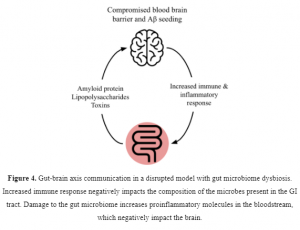
- It is estimated that 1 in 9 individuals over the age of 65 are living with Alzheimer’s disease (AD) and research has shown that the prevalence rate is growing. Currently there is no cure and only limited treatments for AD. Dysbiosis of the gut microbiome has been observed in patients with AD and may contribute to the development of the disease. This study used a transgenic Caenorhabditis elegans AD model to investigate the therapeutic potential of gut microbiome supplementation and punicalagin extract as treatment of AD. Behavioral assays were used to assess the potential amelioration of chemoreception deficiencies of the C. elegans AD model with treatment. It was found that gut microbiome supplementation partially improved chemoreception deficiencies and punicalagin treatment fully improved chemoreception to control level. Both of these treatments have potential as acting as therapeutics for AD.
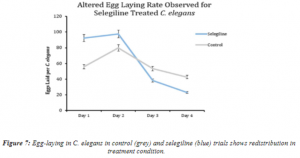
-
Research detailing the mechanisms behind antidepressants, such as monoamine oxidase inhibitors, is lacking. This study investigates the effects of selegiline on the behavior and metabolic pathways of the model organism C. elegans through egg-laying, thrashing, and lipid composition assays. A survey was conducted to contextualize these results in terms of broader impact by demonstrating depression prevalence. Our results showed that selegiline impacts the egg-laying timeline and thrashing frequency of C. elegans. Analyses of lipid assay data show marked differences in fatty acid composition. On a survey measuring depressive symptoms, WPI students averaged a score of 24.3, which is considered at risk for depression. These results highlight the prevalence of depression and the importance of understanding the physiology while providing insight into potential biological mechanisms implicated in depression.
2021: Mechanism of MAOIs in C. elegans, Emily Stead BBT’21
- Research detailing the mechanisms behind antidepressants, such as monoamine oxidase inhibitors, is lacking. This study investigates the effects of selegiline on the behavior and metabolic pathways of the model organism C. elegans through egg-laying, thrashing, and lipid composition assays. A survey was conducted to contextualize these results in terms of broader impact by demonstrating depression prevalence. Our results showed that selegiline impacts the egg-laying timeline and thrashing frequency of C. elegans. Analyses of lipid assay data show marked differences in fatty acid composition. On a survey measuring depressive symptoms, WPI students averaged a score of 24.3, which is considered at risk for depression. These results highlight the prevalence of depression and the importance of understanding the physiology while providing insight into potential biological mechanisms implicated in depression.
2020: Profiling Membrane Lipids in C. elegans Models of Parkinson’s Disease, Ketaki Mehurkar CBC’20*
- Parkinson’s Disease (PD) is a neurodegenerative disease impacting a significant portion of adults worldwide, yet there is no quantitative diagnosis and limited treatments. Several connections have been made between PD and lipids; however, there are limited studies investigating the impacts of PD-linked genes on membrane phospholipids. Here, membrane lipids of C. elegans mutants and RNAi knockdowns of putative Parkinson’s genes were characterized by mass spectrometry. Altered membrane composition was found in synaptic vesicle recycling gene unc-26. Normal membrane composition was rescued with fatty-acid desaturase knockdowns, showing the potential for further studies exploring the disease mechanisms and treatment potential of lipids in Parkinson’s Disease.
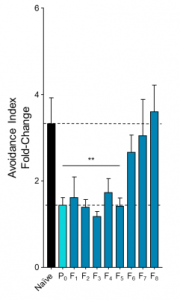
- An animal’s response to their external environment is regulated by highly conserved neural pathways. Environmental cues result in epigenetic alterations, or reprogramming, play a role in transgenerational inheritance. C. elegans sense external cues through chemosensation and communicates to conspecifics through ascarosides, a pheromone class. One ascaroside, osas#9, has been shown to trigger avoidance response alterations across multiple generations. Here in this paper I show that pre-exposure to osas#9 triggers neurologic responses activating the serotonergic and glutamatergic pathways in adult C. elegans. In addition, pre-exposure causes H3K4 demethylation, down regulating transcription activation and avoidance behaviors. Studying how the nervous system senses the environment and the downstream genetic machinery that triggers epigenetic reprogramming is an essential part in understanding what builds us outside of genetics.

-
Selective Serotonin Reuptake Inhibitors (SSRIs) have been a commonly prescribed treatment for mood disorders such as anxiety and depression since their introduction in 1987. However, very little research shows that we fully understand how these drugs work biochemically and how they affect downstream communication within the nervous system. Using C. elegans as a model organism, the impacts of SSRIs can be measured through communication and avoidance behaviors and the results can be applied to humans. Experiments using sertraline hydrochloride showed that SSRIs inhibited avoidance behaviors which reduces survivability of the worm when put in the context predator/prey cues. This is related to the effects that SSRIs have on humans by connecting the avoidance behaviors of C. elegans to the side effects that are the result of long-term SSRI usage.
2020: Central MA Nematode Resilience, Devin Cunningham BBT’20*
- In an effort to relate soil health to the distribution and attributes of nematode species, 6 sites in Worcester, Massachusetts with industrial history were sampled for nematode populations. The presence of nematodes was detected in all soil samples, with three samples producing nematodes that were successfully cultured. The cultured nematodes were grown on agar plates of varying pH values, to investigate their resilience and the impact of the pH on their growth rates. It was found that the nematodes generally grew best at a pH closest to the pH of the soil they came from, indicating that the nematodes present at these sites are well adapted to, and have been selected for or possibly even evolved in response to, the local soil conditions of Worcester.
2019: Sex Pheromone Attractive Response in C. elegans and Related Species, Jane Lockery BBT’19
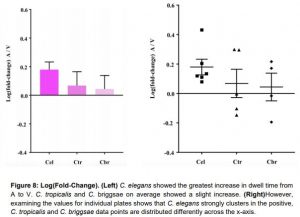
- The nematode Caenorhabditis elegans uses pheromones as a primary means of communication. One pheromone is ascaroside #8 (ascr#8), which is secreted by hermaphrodites to attract males. Since pheromones can be effective in closely related species, I performed behavioral assays to investigate whether an attractive response to ascr#8 would be seen in the other two hermaphroditic species in the Caenorhabditis genus, C. tropicalis and C. briggsae. My data shows differences in the levels of attraction to ascr#8 among the three species, implying that the response is unique to C. elegans.
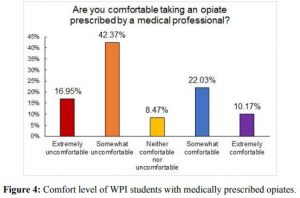
- One of the most prominent addictions of the modern age is to opioids. While opioids originated as a pain relief treatment, their use has increased in the United States steadily since 1990. To study the impact of opioids on a compact neurological system, the model roundworm Caenorhabditis elegans was used. β-Endorphin, an endogenous human opioid, was administered to C. elegans and observed for changes in locomotive behavior. Our results revealed a reduction of speed of the worms treated with β-Endorphin versus a water control. These findings suggest that β-Endorphin has an effect on C. elegans and can be useful model in studying addiction in these systems.

- To understand the balance between “nature versus nurture”, we developed a paradigm to test behavioral epigenetics in the nematode, Caenorhabditis elegans. We hypothesized that pre-exposure to an aversive pheromone, octopamine-succinylated ascaroside #9, would result in a change in the behavior observed upon sensation, and that this change would be seen across multiple generations. We show that pre-exposure results in a decrease in avoidance that is observed across three generations. Overall, the data exemplifies how nurture can later affect nature.
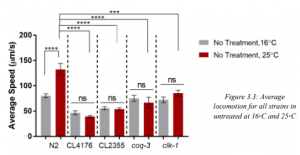
- The prevalence of Alzheimer’s Disease (AD) is rising worldwide. Characterized by accumulation of amyloid-beta plaques in the brain, AD results in loss of cognitive and motor functions, with a theorized link to metabolism and ATP production. This study used transgenic AD-model and metabolic mutant Caenorhabditis elegans to investigate punicalagin and coenzyme Q10 treatments through behavioral and ATP-quantifying assays. Both treatments were successful in rescuing chemosensation in AD and metabolic mutant strains, suggesting a metabolic deficiency that results in olfactory dysfunction.
- In the healthy brain, excitation/inhibition (E/I) balance regulates normal brain function. Microglia, the resident immune cells of the central nervous system, are intricately involved in brain homeostasis. The role of microglia in E/I balance was investigated using chemically induced seizures on mouse models with defective microglia and it was shown that the knockout models experienced increased seizure severity. Understanding the role of microglia in E/I balance will provide new insights into neuropsychiatric disorders such as Autism Spectrum Disorder.
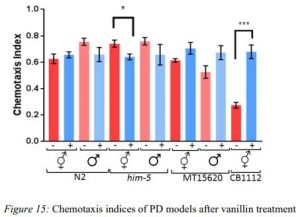
- Parkinson’s disease (PD) and Amyotrophic Lateral Sclerosis (ALS) are common neurodegenerative disorders exhibiting male gender biases. The gender-related differences at both symptomatic and therapeutic levels are not understood. We developed C. elegans models for studying both disorders, and examined gender differences in symptom presentation using behavioral assays measuring locomotion and chemosensory abilities. Symptoms exhibiting gender bias had limited presentation in our models. Additionally, we investigated the efficacy of two potential treatments, caffeine and vanillin. We found that while treatment with caffeine had mixed results based on disease type, vanillin reduced neuronal deficits in both PD and ALS models.
2017: Multisensory Integration and the Regulation of Aversive Behaviors in C. elegans, Jaden Yabut BBT’17
- Caenorhabitis elegans uses a system of chemosensation to survive, making it suitable for studying mechanisms of behavior. Octopamine Succinyl Ascaroside #9 (osas#9) is released by starving larvae and causes individuals to perform avoidance behaviors. Starved Young Adult worms attenuate avoidance by detecting an E.coli metabolite. Avoidance assays were performed with metabolites L-Proline and Cyclo(Phe-Pro), and on C.elegans loss of function mutants to determine specificity attenuation. Neither L-Proline nor Cyclo(Phe-Pro) in single or synergistic treatments recreated attenuation seen using E.coli extract, and attenuation was observed to be dependent on the presence of serotonin and gpa-2/gpa-3 alpha-subunits, implicating the ADF neuron as part of the neuronal circuit for attenuation.
- Maternal RNAs are transferred through the oocyte cytoplasm to the fertilized progeny. In metazoans, these transcripts play a critical role in patterning embryonic development prior to the maternal-to-zygotic transition. The 3’UTR appears to be the primary determinant controlling the pattern of maternal RNA expression in the germline and in the embryo. The 3’UTR also directs robust translation in male gametes, suggesting a possible role for mRNA inheritance through the male germline in C. elegans. Specifically, the set-2 3’UTR drives strong translation of a GFP reporter in sperm. This study aims on identifying cis acting elements in this UTR that confer strong sperm-specific translation, and screening for trans acting RNA binding proteins that influence sperm translation efficiency.
2017: The Role of Serotonin in the Avoidance Attenuation Response of C. elegans, Megan Andresano CBC’17*
- C. elegans is capable of detecting and responding to various odors and pheromones, including several ascarosides- small molecules produced by C. elegans which enable intraspecies communication. Octapamine Succinyl Ascaroside #9 (osas#9) is released by starved L1 C. elegans larvae and induces an olfactory avoidance response. However, due to multisensory integration in response to osas#9 and an unknown metabolite in OP50 E. coli, the avoidance behavior is attenuated in young adults. Avoidance behavior assays and attenuation assays were performed and determined the need for the MOD-1 serotonin gated chloride channel and implicated the possible partial involvement of the serotonin uptake transporter MOD-5 and the neuropeptide receptor NPR-1 in attenuation of the osas#9 avoidance pathway.
- I am interested in understanding the roles of different subunits in controlling the polarized localization of exocyst. Specifically, I asked what happens to the structure, stability and localization of exocyst when other subunits are degraded. An auxin induced degradation system (AID) will be used with the subunits Sec3, Sec6, and Exo70 to determine if the structure of the complex is affected by this degradation. The AID system allows for rapid depletion of targeted proteins in response to the hormone auxin. I took advantage of the GFP tag on Sec8 in order to determine what subunits are still attached to Sec8 when degradation occurs, by pulling down the complex onto GFP bound nanobody beads. Next, I determined where Sec8-GFP is localized in the cell after Sec6, Sec3, and Exo70 degradation.
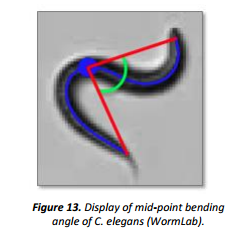
- Alzheimer’s disease is the fifth leading cause of death in the United States and the rate of diagnosis is increasing steadily. It is imperative to understand the pathology of the disease and its underlying mechanisms in order to develop potential therapies. This neurodegenerative disease involves neuronal death and brain atrophy associated with the presence of amyloid-β plaques. Alzheimer’s disease leads to impaired memory and cognitive skills, as well as the disruption of everyday tasks, such as movement and speech. Currently there is no cure for Alzheimer’s disease; there are only therapies intended to manage symptoms. Our study focused on Caenorhabditis elegans models of Alzheimer’s disease and the ability of natural extracts to prevent the onset of symptoms caused by the disease. C. elegans is often used in the scientific community as a model organism due to the fact that its entire genome is sequenced and mapped, its neuronal connections are known – making research easier and more effective. We studied the effects of two polyphenols found in plants, punicalagin and tannic acid, as they have been shown to have antioxidant and anti-inflammatory properties, implicating neuroprotective effects. In this study, C. elegans behavioral assays were used to study the effects of punicalagin and tannic acid in combatting the effects of the amyloid-β peptide. These assays tested the chemosensation and the muscular deficits as Alzheimer’s disease can cause olfactory defects and paralysis in patients. Our results suggested that punicalagin reduces the neuronal deficits caused by the accumulation of the amyloid-β peptide, while tannic acid was not shown to have a rescuing effect.
2016: Analyzing the dysfunction of profilin1 in ALS, Victoria Botelho BBT’16
- Amyotrophic lateral sclerosis (ALS) is a fatal neurodegenerative disease which affects motor neurons in the brain and spinal cord. This project analyzed the ALS-associated protein, profilin 1 (PFN1). Multiple experiments were completed in order to analyze what occurs when profilin is not functioning correctly. Cloning, transfection, creating knockdown lines, and observing cells using fluorescent imaging where among the tools used to analyze wildtype PFN1 and ALS-mutant PFN1.
2015: The Role of Nutrition in Regulating Aversive Behavior, Alexander Turland BBT’15
- All organisms are constantly interacting with multiple stimuli; sensing and processing them, which ultimately results in behavior. The internal processes which govern these behaviors are complex and remain largely unclear. The nematode Caenorhabditis elegans detects hundreds of small molecules to aid in navigating and surviving within its habitat, rendering it a strong model system for elucidating these mechanisms. These molecules may be generated by other species or by conspecifics. One class of molecule released by C. elegans are the ascarosides, which function as intraspecies pheromones. Octopamine Succinyl Ascaroside #9 (osas#9) is one such ascaroside which is released by starved young larvae, likely communicating/indicating that an area lacks food. When individuals sense this molecule, they avoid the area by undergoing an innate avoidance response, characterized by backing out and initiating a reversal motor program. However, in the presence of osas#9 and the microbial food source, Escherichia coli, C. elegans does not perform an avoidance response, suggesting that food negates the osas#9 aversive cue. This information served as a basis for testing which, if any, molecular metabolites released by E. coli attract C. elegans and negate the osas#9 avoidance response. A dose response curve was generated for the bacterial metabolite(s) with respect to osas#9, and the neuron responsible for detecting the metabolite(s) was identified. These results were used to analyze the neural basis of an innate choice-driven avoidance response.
2014: The Effect of Nutritional State on Social Behaviors in C. elegans, Bethany Burke CBC’14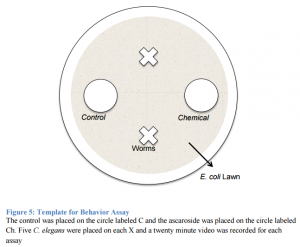
- In order to determine if nutrition has an effect on social behaviors, this project looks at C. elegans and their responses to endogenously produced small-molecules called ascarosides. This project involves the classification of behavior using behavior assays and different nutritional states including well-fed, starved and a high glucose diet. In particular, the project looks at sex-specific behaviors. It was found that both males and hermaphrodites are attracted to ascr#3 and ascr#8 when well-fed. When starved, males are still attracted to ascr#8 whereas hermaphrodites lose their attraction. Growing males and hermaphrodites on glucose plates do not change their response to ascr#8 in either the fed or starved condition. Using the daf-2 mutant (an insulin signaling mutant), growing hermaphrodites on glucose plates or agar plates did not elicit a response to ascr#8 in the fed condition. It is important to research this topic as it can provide insight into how the physiology and biochemical pathways of nutrition may be influenced in order to cause favorable social behaviors.
2013: Nematode Diversity in Central Massachusetts, Laura Aurilio BBT ’13
- Soil nematodes can be found in a wide variety of natural habitats and environmental conditions. The presence of these animals, while not regularly recognized, has a huge impact on the area’s ecology as far as soil turnover and nutrient availability (Yeates, 2003). Knowing what specific types of nematodes can be found in defined areas can help to assess factors such as environmental health (Yeates, 2003). While gamma and beta-diversity (biodiversity between ecosystems) of nematodes has been assessed in the past, little attention has been paid to small scale nematode biodiversity, also known as alpha-diversity. This project, through two different extraction methods, examines the alpha-diversity of nematodes in the Central Massachusetts region of New England, where no nematode-specific biodiversity studies have been done before. Nematodes were isolated from seventeen towns within the Central Massachusetts region, from five separate sub-regions. It was found that nematodes could, in fact, be isolated from each of the seventeen towns through one or both isolation methods, but abundance of nematodes and time to isolate the nematodes varied from location to location. Environmental factors from isolation sites were also noted. The most attention was given to soil pH conditions for each town. It was found that there is a certain pH range most optimal for nematode isolation falling within 4.51-5.00. After isolation, PCR was completed on single worms to amplify the DNA using the Small Subunit rRNA molecular marker (SSU). Sequencing was then done on the amplified nematode DNA samples from Hopedale and two Pristionchus species were found: P. marianneae and P. pauli.
Student Majors
BBT = Biology and Biotechnology Department
BCB = Bioinformatics and Computational Biology Department
CBC = Chemistry and Biochemistry Department


